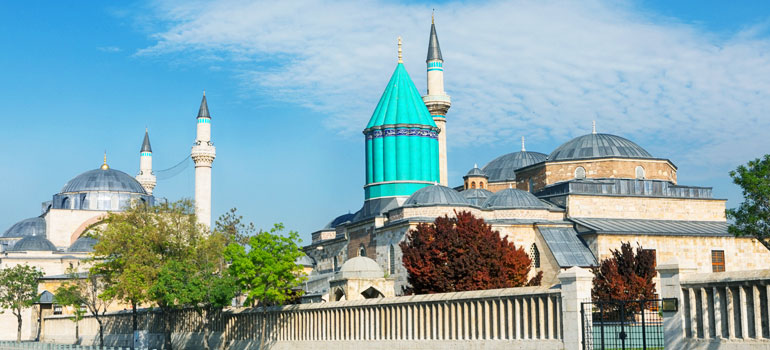Mevlana Tomb
- Mevlana Tomb is located in Karatay district of Konya. While the location of the “Mevlana Lodge”, which operates as a museum today, is the “Rose Garden of the Seljuk Palace”, the garden was gifted to Mevlana's father “Bahaeddin Veled” by “Sultan Alaeddin Keykubad”.
- When "Bahaeddin Veled" died in 1231, he was buried in his current place in the tomb. This is the first burial in the rose garden. After the death of Bahaeddin Veled, those who respected and loved him applied to Mevlana and said that they wanted to build a tomb over his father's grave, but Mevlana rejected this request by saying "Is there a better tomb than the sky dome"
- However, when he died in 1273, Mevlana's son Sultan Veled said that those who respected and loved Mevlana wanted to have a tomb built on his grave. Sultan Veled accepted these requests. The tomb, which is called "Kubbe-i Hadra", that is, "Green Dome", was built on four elephant feet (thick columns) by the Architect Bedrettin from Tabriz for 130 thousand Seljuk dirhams. After this date, the construction activities never ended and continued with additions and arrangements until the end of the 19th century.
- Mevlevi Lodge started to serve as a museum in 1926 under the name of "Konya Asâr-ı Atîka Museum". In 1954, the name of the museum was revised and the name of the museum was renamed as Mevlana Museum. While the area around the museum, including its garden, was 6,500 square meters, its place has been rearranged and has reached 18 thousand square meters with the sections organized as the "Rose Garden".
- The courtyard of the museum is entered through the gate called the "Dervişân Gate". There are dervish rooms along the north and west sides of the courtyard. The south direction ends at the gate called the Hâmûşân (Silent) Gate, which opens to the Üçler Cemetery after the Matbah and Hürrem Pasha Tomb. In the east of the courtyard, there is the main building, which includes the tombs of Sinan Pasha, Fatma Hatun and Hasan Pasha, as well as the semahane and masjid sections, and the tombs of Mevlana and his family members. The covered fountain built by Yavuz Sultan Selim in the courtyard in 1512, the pool known as "Şeb-i Arus", and the fountain known as Selsebil, located in the north of the courtyard, add a different color to the Mevlana Museum.
Precious Artifacts in the Mevlana Museum;
- Works belonging to Mevlana and Mevlevi and handwritten books
- Plates, oil lamps and musical instruments are exhibited.
- Specialized library
- Mevlana's Ark
- Pushide (Mevlana's Grave Cover)
- Mathnawi
- April Stone
